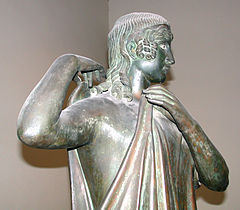- Naples National Archaeological Museum
-
Naples National Archaeological Museum
Museo Archeologico Nazionale di Napoli
Naples National Archaeological MuseumEstablished 1585 Location  Piazza Museo, Naples Italy
Piazza Museo, Naples ItalyType archaeology Public transit access Fermata Museo
(Metropolitana linea 1)
Fermata Piazza Carvour (Metropolitana linea 2)Website Official website The Naples National Archaeological Museum (Museo Archeologico Nazionale di Napoli) is a museum in Naples, southern Italy, at the northwest corner of the original Greek wall of the city of Neapolis. The museum contains a large collection of Roman artifacts from Pompeii, Stabiae and Herculaneum. The collection includes works of the highest quality produced in Greek, Roman and Renaissance times. It is the most important Italian archaeological museum.
Contents
History
Collections
The museum hosts extensive collections of Greek and Roman antiquities. Their core is from the Farnese Collection, which includes a collection of engraved gems (including the Farnese Cup, a Ptolemaic bowl made of sardonyx agate and the most famous piece in the "Treasure of the Magnificent", and is founded upon gems collected by Cosimo de' Medici and Lorenzo il Magnifico in the 15th century) and the Farnese Marbles.
Building
Charles III of Spain founded the museum in the 1750s. The building he used for it had been erected as a cavalry barracks and during its time as the seat of the University of Naples (from 1616 to 1777) was extended, in the late 18th century.
Collections
Among the notable works found in the museum are:
- Herculaneum papyri, carbonized by the eruption of Mount Vesuvius, found after 1752 in Villa of the Papyri
Marbles
The greater part of the museum's classical sculpture collection largely comes from the Farnese Marbles, important since they include Roman copies of classical Greek sculpture, which are in many cases the only surviving indications of what the lost works by ancient Greek sculptors such as Calamis, Kritios and Nesiotes looked like. Many of these works, especially the larger ones, have been moved to the Museo di Capodimonte for display in recent years.
- The Farnese Hercules, which fixed the image of Hercules in the European imagination.
- The Farnese Atlas is the oldest extant depiction of Atlas from Greek mythology, and the oldest view of the Western constellations, possibly based upon the star catalog of Hipparchus
- The Farnese Bull, widely considered the largest single sculpture ever recovered from antiquity.
- The group Harmodius and Aristogeiton, a Roman copy of a bronze work that once stood in the Agora of Athens
- The Venus Kallipygos
- The Farnese Artemis, again a Roman copy of a Greek original
- a collection of busts of Roman emperors
- another set of Roman sculptures (again mainly copies of Greek work) that (like the Hercules) once stood in the Baths of Caracalla in Rome.
Bronzes from the Villa of the Papyri
Mosaics
The museum's Mosaic Collection includes a number of important mosaics recovered from the ruins of Pompeii and the other Vesuvian cities.
Egyptian Collection
The museum has the third largest collection of Egyptian artifacts in Italy, after the Vatican Museum and the Museo Egizio in Turin. It is made up primarily of works from two private collections, assembled by Cardinal Borgia in the second half of the 18th century, and Picchianti in the first years of the 19th. In the recent rearrangement of the galleries the two nuclei have been exhibited separately, while in the connecting room other items are on display, including Egyptian and "pseudo-Egyptian" artefacts from Pompeii and other Campanian sites. In its new layout the collection provides both an important record of Egyptian civilization from the Old Kingdom (2700-2200 B.C.) up to the Ptolemaic-Roman era.[1]
Secret Cabinet
- The Secret Cabinet, a separately housed collection of erotic Roman art.
- The Placentarius, the small bronze statue represents a distinctly ithyphallic old nude man who, on the palm of his hand, holds a little silver tray.
References
- ^ Museo Archeologico Nazionale di Napoli (English)
External links
- Official website
- A perfect site about the Museum
- Museum Guide to Naples information
- Archeonapoli: il MANN
- Il museo nel sito del Ministero
Naples landmarks Albergo dei Poveri · San Francesco di Paola · Cappella Sansevero · Castel dell'Ovo · Castel Nuovo · Certosa di San Martino ·
Gesù Nuovo · National Museum of Capodimonte · Palazzo Reale · Posillipo · San Domenico Maggiore · Santa Chiara · Teatro San Carlo · Galleria Umberto I · Naples Cathedral
Coordinates: 40°51′12.16″N 14°15′1.75″E / 40.8533778°N 14.2504861°ECategories:- Museums in Naples
- Art museums and galleries in Italy
- Archaeology museums in Italy
- National museums of Italy
- Visitor attractions in Italy
- Museums of Ancient Rome
Wikimedia Foundation. 2010.




